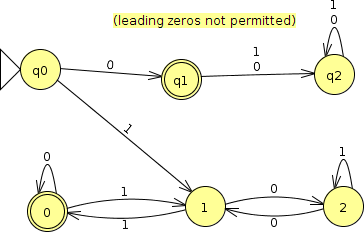

Instruction: For each state we draw a vertex or node. Finite State Automaton Given by a Transition Diagram We give a graph representation of this machine, its state transition diagram which describes the behavior of the machine. This is a minimal 'no frills' vending machine. An example of a finite state automaton is given in the next paragraph.Īssume a simple vending machine that takes a quarter, button-on, and "cup full" as inputs, and coffee as output. There is a distinguished state, so, which is the initial or starting state. In defining them we will again use set theory, showing the wide utility of sets.Ī Finite State Automaton is a tuple (S, I, O, ns, o), where S is a finite set of state, I is a finite set of input symbols, O is a finite set of output symbols, ns a function from S x I to S is the next state function, and o is a function from S to O is the output function. Lastly, Karnaugh maps or Boolean logic rules can be used to simplify (or minimize) the equations, and thus the design.įinite State Automaton, also named finite-state machines, are just a special type of graph. Finally, Boolean equations can also represent the design. A finite state machine diagram can also represent the design: circles represent states arrows represent transitions next to states and inputs and outputs label the arrows (sometimes written as input/ output). Thus, a binary table with entries that give the output and next state for given inputs and current state represents the design of the machine. Recall that state requires memory (that is, flip flops). We use a sequential circuit, because the output also depends on the state. A binary table represents the input/output behavior of the circuit. Thus 4 states require 2 variables, 00, 01, 10 and 11. Each state is assigned a distinct set of 1's and 0's, not using more variables than necessary. This case study gives an example of the design of a sequential circuit. RAND's publications do not necessarily reflect the opinions of its research clients and sponsors.Read this article for an example of a finite state machine design of a simple vending machine.A sequential circuit is also called a sequential machine or a finite state machine (FSM) or a finite state automaton. For more information, visit The RAND Corporation is a nonprofit institution that helps improve policy and decisionmaking through research and analysis. To help ensure our research and analysis are rigorous, objective, and nonpartisan, we subject our research publications to a robust and exacting quality-assurance process avoid both the appearance and reality of financial and other conflicts of interest through staff training, project screening, and a policy of mandatory disclosure and pursue transparency in our research engagements through our commitment to the open publication of our research findings and recommendations, disclosure of the source of funding of published research, and policies to ensure intellectual independence. Our mission to help improve policy and decisionmaking through research and analysis is enabled through our core values of quality and objectivity and our unwavering commitment to the highest level of integrity and ethical behavior. Papers were less formal than reports and did not require rigorous peer review.
#Finite state automata professional
The paper was a product of the RAND Corporation from 1948 to 2003 that captured speeches, memorials, and derivative research, usually prepared on authors' own time and meant to be the scholarly or scientific contribution of individual authors to their professional fields. This report is part of the RAND Corporation Paper series.


 0 kommentar(er)
0 kommentar(er)
